Bridgestone Introduces POTENZA S001 RFT,
Run-flat Tire for the Replacement Market in JapanFor a Safer and More Environmentally Friendly Driving Experience
Tokyo (June 17, 2011)—Bridgestone Corporation today announced the launch of the first run-flat tire*1 for the replacement market*2 in Japan, the POTENZA S001 RFT. The POTENZA S001 RFT will be marketed in four different sizes beginning July 1, 2011.
As environmental awareness grows worldwide, automakers are accelerating the introduction of lighter, smaller vehicles. In response to this growing trend, Bridgestone has developed its run-flat technology that will significantly advance the use of run-flat tires by original equipment manufacturers. Additionally, run-flat tires also eliminate the need for spare tires (emergency-use tires) in passenger vehicles. The company believes that further advancements in performance and the environment-friendly aspects of run-flat tires, like the new POTENZA S001 RFT, can make a major contribution to society.
1. Features of Run-flat Tires
2. Evolution of Run-flat Tires
3. Characteristics of POTENZA S001 RFT
Products are summarized as follows.
1. Product Name

2. Performance Evaluation

3. Technologies and Product Features

(Summary of NanoPro-Tech technology)
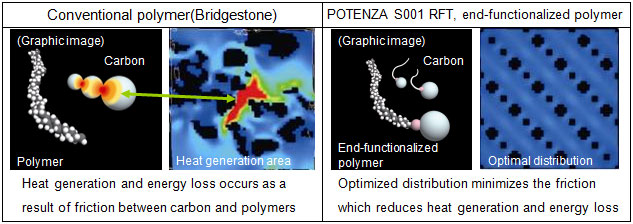
 ♦Tire exterior
♦Tire exterior
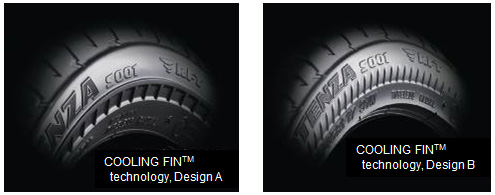
♦How the COOLING FIN™ technology promotes airflow disturbance

♦Benefits of COOLING FIN™: Comparison of Tire Sidewall Surface Temperatures
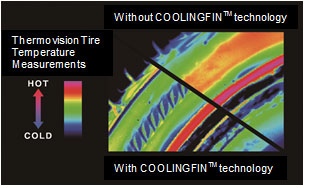
As environmental awareness grows worldwide, automakers are accelerating the introduction of lighter, smaller vehicles. In response to this growing trend, Bridgestone has developed its run-flat technology that will significantly advance the use of run-flat tires by original equipment manufacturers. Additionally, run-flat tires also eliminate the need for spare tires (emergency-use tires) in passenger vehicles. The company believes that further advancements in performance and the environment-friendly aspects of run-flat tires, like the new POTENZA S001 RFT, can make a major contribution to society.
1. Features of Run-flat Tires
(1) Bridgestone's run-flat tires have three major advantages:
・Improved driving stability should the tire experience air loss
・Greater peace of mind. Should air loss occur, there is no need to change tires in dangerous places, such as busy highways or at night
・Continued mobility should a puncture damage the tire tread and sidewalls
(2) Eliminating spare tires from vehicles globally would help save resources by reducing approximately 59 million*3spare tires annually. Furthermore, CO2 emissions over the spare tire lifecycle-from raw material procurement to disposal-could be lowered by approximately 2 millions tons of CO2 per year.*4 Additional CO2 emissions can be further reduced by the elimination of the wheels used for the spare tires.
2. Evolution of Run-flat Tires
The mainstay of Bridgestone's run-flat tire design includes a reinforced sidewall. When Bridgestone began mass production of run-flat tires in 1987, the ride quality was considered "hard" compared to conventional tires because the sidewalls were thick and somewhat inflexible. Since 2005, however, improvements have been made to sidewall reinforced rubber that enhanced riding comfort. 'Heat control technology,' developed and commercialized in 2009, has helped make the ride even smoother.
3. Characteristics of POTENZA S001 RFT
(1)POTENZA S001 RFT uses new side-wall reinforced rubber and COOLING FIN™ technology, both of which control heat, creating a more comfortable ride that is comparable with POTENZA S001 (conventional tires).
(2)Like POTENZA S001, which was introduced in 2010 and well received by customers, it delivers higher dimensional dry and wet performance. As a result, Ferrari 458 Italia, Aston Martin Rapide, and Lexus LFA vehicles are equipped with POTENZA S001 tires.
(3)POTENZA S001 RFT is recommended for two types of customers:
(i) Those demanding run-flat tires in new cars for a smoother ride
(ii) Those wanting the performance features of run-flat tires in vehicles that are now using conventional tires. However, a car using conventional tires can only be equipped with POTENZA S001 RFT*5 if it can be fitted with the TPMS B-01 tire pressure monitoring system*6 in combination with aluminum wheels*7 sold on the replacement market.
*1 Run-flat tires can be driven with zero inflation pressure for a limited distance at a reduced speed.
・Under normal driving conditions at 0kPa inflation pressure, run-flat tires can be driven for up to 80km at 80km/h (ISO technical standard).
・80km is the distance drivable under test conditions based on ISO technology standards. Actual drivable distances vary depending on load, outside temperature, and other conditions in use.
*2 Summer tires for replacement market.
*3 Bridgestone investigation (from total cars with spare tires, as measured by total passenger cars manufactured worldwide in 2008, minus cars with run-flat tires or with repair kits).
*4 Based on CO2 emissions over the lifecycle of Bridgestone's temper TR2 (145/70R18 107M) tires. CO2 emissions are calculated in accordance with the Japan Rubber Manufacturers Association's "Tire Inventory Analysis Trials" (1998). Emissions are considered to be zero during the usage stage.
*5 Capable of installation in two sizes: 195/55RF16 87V and 225/45RF17 91W.
*6 The tire pressure monitoring system (TPMS) monitors and informs the driver of the tire inflationary pressure using sensors attached to the wheel. TPMS recommended by Bridgestone are required when using POTENZA S001 RFT. TPMS B-01 is sold at COCKPIT Tire-Kan stores authorized to sell TPMS devices.
*7 In some vehicles, systems can be attached to aluminum wheels on new cars. They cannot, however, be attached to steel wheels. Please use only recommended replacement market aluminum wheels.
Products are summarized as follows.
1. Product Name

Tire Sizes | |||
|---|---|---|---|
195/55RF16 87V | 205/55RF16 91V | 225/45RF17 91W | 245/40RF18 93W |
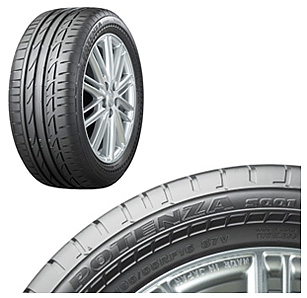 |
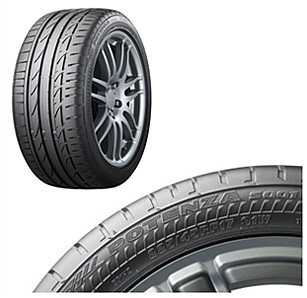 | ||
※ Please note that COOLING FIN™design varies by tire size.
2. Performance Evaluation

(Test Conditions)
Conventional tires(POTENZA S001): 245/40R18 97Y XL
Previous run-flat tires (POTENZA RE050 RFT): 245/40RF18 93W
POTENZA S001 RFT:245/40RF18 93W
Test load:4.71kN
Air pressure:240kPa
Testing method: Static load characteristics testing
Testsite: Facilities located at Bridgestone Technical Center
Conventional tires(POTENZA S001): 245/40R18 97Y XL
Previous run-flat tires (POTENZA RE050 RFT): 245/40RF18 93W
POTENZA S001 RFT:245/40RF18 93W
Test load:4.71kN
Air pressure:240kPa
Testing method: Static load characteristics testing
Testsite: Facilities located at Bridgestone Technical Center
* The tire acts as a spring, absorbing the shock between a vehicle and the road surface.
The index expresses the "strength of the spring".
The index expresses the "strength of the spring".
* The tire vertical stiffness of conventional tires is indexed at 100. Riding comfort improves as numbers fall on the index.
3. Technologies and Product Features
(1) Heat Control Technology
Heat control technology is a major reason ride comfort compares favorably with conventional tires. The most effective way to improve ride comfort from sidewall-reinforced run-flat tires is to make tire sidewalls thinner and more flexible. However, when tires puncture, tire sidewalls can suddenly warp and generate greater heat. The biggest challenge to maintaining or increasing run-flat tire durability (after air pressure is lost) and enhancing riding comfort is coping with heat generation. Bridgestone's heat control technology resolves this problem.
Heat control technology is a major reason ride comfort compares favorably with conventional tires. The most effective way to improve ride comfort from sidewall-reinforced run-flat tires is to make tire sidewalls thinner and more flexible. However, when tires puncture, tire sidewalls can suddenly warp and generate greater heat. The biggest challenge to maintaining or increasing run-flat tire durability (after air pressure is lost) and enhancing riding comfort is coping with heat generation. Bridgestone's heat control technology resolves this problem.
(a) New Sidewall-reinforced Rubber that Curbs Heat Generation
Through the technology of NanoPro-Tech, we have created a new sidewall-reinforced rubber with improved carbon dispersion. The design reduces friction that occurs between carbon molecules when the tire is loaded thereby reducing heat generation. Compared with previous sidewall-reinforced rubber, NanoPro-Tech can reduce by half the heat generation that occurs due to the deformation of tire sidewalls when driving on tires that have lost air pressure.
Through the technology of NanoPro-Tech, we have created a new sidewall-reinforced rubber with improved carbon dispersion. The design reduces friction that occurs between carbon molecules when the tire is loaded thereby reducing heat generation. Compared with previous sidewall-reinforced rubber, NanoPro-Tech can reduce by half the heat generation that occurs due to the deformation of tire sidewalls when driving on tires that have lost air pressure.
(Summary of NanoPro-Tech technology)

*More detailed data on the testing conditions noted above were submitted to the Tire Fair Trade Commission (TFTC).
*Testing defined under rules for fair competition applied to tires.
*Test results pertain only to testing and may change depending on driving methods.
(b) COOLING FIN™ technology to Cool Tire Sidewalls
COOLING FIN™ technology features protrusions, which face toward the center of the wheel, on the surface of tire sidewalls in order to create disturbances in the airflow and thereby cool the tire. The technology helps to cool sidewall heat generated when driving on tires that have lost air pressure.
COOLING FIN™ technology features protrusions, which face toward the center of the wheel, on the surface of tire sidewalls in order to create disturbances in the airflow and thereby cool the tire. The technology helps to cool sidewall heat generated when driving on tires that have lost air pressure.

♦How the COOLING FIN™ technology promotes airflow disturbance

*The small dots represent airflow, and the color of the dots represents the speed of airflow. Green or red-brown colored dots represent faster airflow than blue dots.
♦Benefits of COOLING FIN™: Comparison of Tire Sidewall Surface Temperatures

|
(Test conditions) Tire size:225/45R17 Test air pressure:0kPa Test load:3.92kN test Rim width:7.5 inches Test speed:80km/h Test method:Tire surface temperature taken by internal drum testing device after 30-minute rotation. |
*More detailed data on the testing conditions noted above were submitted to the Tire Fair Trade Commission (TFTC).
*Testing defined under rules for fair competition applied to tires.
*Test results pertain only to testing and may change depending on driving methods.
(2) Superior dry and wet performance
Like POTENZA S001, introduced in 2010, which achieved a positive reputation from customers, POTENZA S001 RFT delivers higher dimensional dry and wet performance.
Like POTENZA S001, introduced in 2010, which achieved a positive reputation from customers, POTENZA S001 RFT delivers higher dimensional dry and wet performance.
<Reference data 1>History of Run-flat Tires
Bridgestone's run-flat tire initiatives trace their origins to the early 1980s, when the Company began manufacturing tires that enabled vehicles for the physically disabled to be driven even after a loss of air pressure. In 1987, the selection of Bridgestone run-flat tires as a standard equipment for the Porsche 959 heralded the Company's start-up of manufacturing for mass-produced vehicles. Since 1999, automakers have responded to society's changing automotive needs by bringing more models to market with run-flat tire specifications.
<Reference data 2>Sidewall-reinforced Type Run-flat Tires

| In line with its status as company with a vast global presence, Bridgestone has formulated a universal environmental policy, dubbed “One team, One Planet, ” to unite it with people and organizations beyond the standard corporate framework as well as to ensure the safety of the children of the world. |

| This mark expresses the environmental management activities promoted by Bridgestone. The “e” represents the first letter of the word “Ecology”, the cornerstone of these activities. The mark also symbolizes the seeds borne from our eco foundations in the form of a clear sky and growing trees. |
About Bridgestone Corporation:
Bridgestone Corporation, headquartered in Tokyo, is the world's largest tire and rubber company. In addition to tires for use in a wide variety of applications, it also manufactures a broad range of diversified products, which include industrial rubber and chemical products and sporting goods. Its products are sold in over 150 nations and territories around the world.
Bridgestone Corporation, headquartered in Tokyo, is the world's largest tire and rubber company. In addition to tires for use in a wide variety of applications, it also manufactures a broad range of diversified products, which include industrial rubber and chemical products and sporting goods. Its products are sold in over 150 nations and territories around the world.


